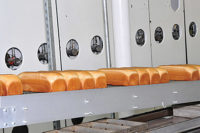Enriching war efforts
In the 1940s with America marching off to war, The Taggart Baking Co. introduced another breakthrough: Fortified bread. The Wonder Bread folks also discovered a new way of baking that could eliminate holes in bread.
According to Popular Mechanics Magazine, it took 584 million loaves of bread to feed the U.S. army for a year in WWII. The ABA began training soldiers to be “expert bakers” during the war. When male teenagers graduating from high school couldn’t pass their physical examinations, the enrichment standards for baked goods provided a vehicle for improved nutrition. ABA’s tagline at the time was, “Bread is the Staff of Life.”
Since 1941, refined grains have been enriched with iron and B vitamins, including riboflavin, niacin and thiamine, which collectively help maintain a healthy nervous system and increase energy production, which may lower cholesterol. Thus a U.S. enrichment policy was being established and, pellagra and beriberi were being eradicated from the population.
Manufacturers also started adding calcium to flour in 1941 to prevent rickets. Rickets had been detected in Britain when World War II broke out. By May of that year, when President Roosevelt called a National Nutrition Conference for Defense, standards for enriched flour had been established. An agreement had been reached with the Food and Drug Administration on recommendations of the Food and Nutrition Board that bread be considered enriched if it contained enrichment nutrients at levels found in bread made with enriched flour.
After the enriched standard became effective, the use of enriched flour grew substantially across the nation, according to data provided by the ABA. The War Food Administration eventually required fortification as a result of the increased popularity. So when the Washington Conference endorsed the Food and Nutrition Board’s advances in vitamin research and the nation’s health, it was possible to launch bread as well as flour enrichment programs. Enriching bread and flour with vital nutrients had surprisingly positive effects in improving the health of the public. Much of this was owed to AIB’s Department of Nutrition for its achievements in vitamin studies and research.
1941 was also a landmark year for master baker Steve Giraudo, Sr., who bought the popular but financially troubled Boudin Bakery in San Francisco, which originated there in 1849. Giraudo purchased the bakery from the grand-daughter of Isidore and Louise Boudin, with the family’s full support, and saved a San Francisco sourdough baking tradition. Giraudo stayed true to the original artisan sourdough recipe for the bread and used no fat, sugar, preservatives or dough conditioners. He spent virtually every day at this bakery until his death in 1997.




















